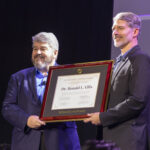
Nichelle Trulove -- Engineering students Alex Muganza, Andre Nodem, David Kari and Bertrand Dushime interact with robot Lance 1.

As a result of receiving a quarter of a million dollar grant, the School of Engineering will soon have their hands on state of the art equipment and technology that will allow them to “do computing very efficiently and very fast,” Anthony Donaldson, dean of the School of Engineering, said. It will also provide funding for additional equipment purchases.
The Field Programmable Gate Array, which is the technology to be purchased, “is going to be pushed into the curriculum through this lab funding in at least six to eight courses,” he said.
The funding was officially granted in Jan. 2012 by the W.M. Keck Foundation, a philanthropic institution that focuses its generosity on science and engineering research, medical research, undergraduate education and Southern California as a whole.
Many other Southern California universities have been awarded similar grants, including the University of Redlands, which received three-year funding beginning in 2010 for LENS, a campus-wide initiative promoting spacial literacy.
California Baptist University began the application process for a W.M. Keck grant four and a half years ago, which is approximately one year after the School of Engineering was established.
“We’ve been talking with [the W.M Keck Foundation], and they followed the progress of our college of engineering, and we reached a point where they were very pleased with what they saw,” Art Cleveland, the vice president of Institutional Advancement, said.
Once unofficial approval was given by the organization after multiple talks, CBU officials saw fit to apply for a Phase 1. Phase 1 gives a basic idea of what the School of Engineering wanted to do with a grant.
The W.M. Keck Foundation was pleased with the Phase 1 proposal and prompted CBU to apply for Phase 2.
“If you get the approval of Phase 2, well, then you get funded, and then so we did,” Cleveland said.
The School of Engineering anticipates purchasing and using equipment and technology that will advance their program this spring. One of the major acquisitions will be multiple NAO robots, which will bring the total of the School of Engineering robots to four, allowing them to participate in the annual international RoboCup soccer competition.
This special type of walking robot is 23-and-a-half inches high and has speaker recognition, voice recognition and image recognition.
One student, senior David Kari, will be working with a team on these robots for his senior design project to give it touch sensor capability. He said, “The NAO is not only the best humanoid robot likely available on the market, it is also one of the most expensive. Without financial support from grants, such as the Keck Grant, advanced robotics research would be impossible.”
CBU at large is excited about the boost this grant will give an already growing department, according to Cleveland.
“I was very excited for the engineering college and the faculty there, because it will enable them to do some things…that they would not be able to do otherwise, because it’s very specialized equipment and it’s not equipment that you would normally just get year-to-year,” Cleveland said. “It’s a big chunk of money to get some equipment that will allow us to further things in the robotics and the nanotechnology area. It’s cool! Of course, ‘cool’ probably isn’t a word for the vice president to use, but it is.”


